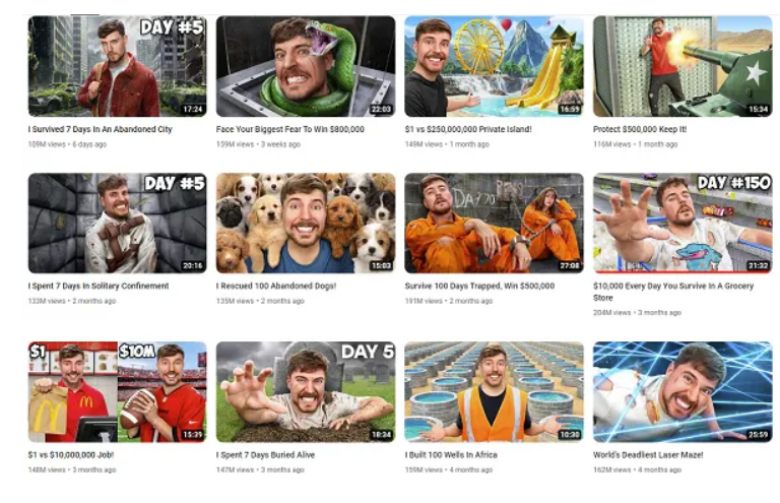
Quick Summary
- YouTube’s algorithm rewards watch time, engagement, and viewer satisfaction over subscriber count alone.
- Viral videos come from mastering the trinity: compelling thumbnails, irresistible titles, and powerful hooks in the first 15 seconds.
- Consistency and native content win over fleeting trends.
What if a single video could transform your business overnight?
On YouTube, companies go from startup to acquisition, creators become millionaires, and brands reach audiences they never imagined possible—all from one viral moment that captures the platform’s massive potential.
The YouTube Advantage: Where Strategy Meets Algorithm
YouTube is a video platform, a search engine, a storytelling stage, and a conversion powerhouse. What makes it different from platforms like TikTok or Instagram is how content spreads.
YouTube’s algorithm prioritizes watch time, retention, and viewer satisfaction, not just the number of subscribers. That means long-form, high-quality content has the power to outperform flash-in-the-pan virality.
And unlike the fleeting buzz of short-form platforms, a viral YouTube video can keep gaining momentum for weeks, months, even years.
Even better? You don’t need millions of subscribers or massive budgets. Quality content can outperform big-dollar productions. All it takes is strategic content and smart optimization.
Viral Success Blueprints from Top YouTube Creators
The difference between a good video and a viral sensation often lies in replicable, behind-the-scenes strategy—not luck.
Below, we break down the exact tactics top YouTubers use to consistently generate millions of views, subscribers, and engagement.
1. Master the thumbnail and title combination
Known for his YouTube stunts and philanthropy, MrBeast goes viral with his jaw-dropping challenges, giveaways, and content that breaks the internet. To maintain a strong brand, MrBeast and his team create 20+ thumbnail variations per video, spending up to $10,000 on a single image.
 Source: Social Media Today
Source: Social Media Today
Why? Because the thumbnail and title are the handshake that gets the click. You only get one shot to grab attention, so choose the best introduction to launch your desired chain reaction.
Why it works: Bold visuals paired with emotional titles spark curiosity and promise something real. Think: “I Gave Away $1,000,000” or “Last To Leave Wins $10,000.” Every word and pixel must earn attention.
How to steal this strategy: A/B test multiple thumbnail and title versions. Optimize for emotion, clarity, and curiosity.
2. Hook viewers in the first 15 seconds
Dollar Shave Club proved that humor, bold, branding, and a less pricey product could disrupt an entire industry. The brand initially went viral with its $1 razors by mail and now defines what a YouTube brand video could be.
With a sharp hook in the first few seconds, they grabbed attention, delivered humor, and created trust, all in under 2 minutes. The results: 3 million views in two weeks and 12,000 new subscribers in 48 hours.
The key to this strategy: Open with a bold claim, startling question, or emotionally charged moment. Make viewers need to see what happens next.
How to apply it: Write your intro like an ad: high impact, zero fluff, emotionally resonant.
3. Build consistent content formats that work
Educational kids’ creator Ms. Rachel has captured the hearts of parents, teachers, and toddlers around the world with her fun and engaging learning videos. She turns songs, games, and popular characters into vibrant videos, each with a predictable format and value promise.
This formula has earned her millions of views using repeatable content frameworks. Each thumbnail reflects her fun branding and each video delivers exactly what’s promised in the title.
What makes it tick: Develop a recognizable series to build familiarity and viewer loyalty.
Put it into practice: Package your expertise into a repeatable format, then stick to it.
The strategy: Create recognizable series that build anticipation and viewer loyalty.
4. Optimize for YouTube search and discovery
SEO software brand Ahrefs provides essential SEO tools, along with a massive resource library to put their software and general SEO know-how into practice. It also practices its own advice by optimizing videos for YouTube SEO.
Each playlist focuses on a core topic, like affiliate marketing or link-building, to build deep topical authority. Their evergreen content ranks in search and delivers consistent value over time.
How it delivers results: Blend trending formats with timeless topics that solve audience problems.
Make it work for you: Research long-tail keywords. Create videos that directly answer them. Rinse and repeat.
5. Tell compelling stories that create emotional investment
Yes Theory is a group of adventure seekers who live by the motto, “Seek Discomfort.” They take on viral challenges, surprise guests with monetary gifts, and prove that viral content can also be deeply human.
Yes Theory built its 9M+ subscriber base by leaning into a lifestyle of saying “Yes.”
Their most viral videos aren’t flashy stunts—they’re deeply human stories. From convincing strangers to fly across the world to confronting personal fears on camera, every video invites emotional connection.
How it hooks and holds: Their storytelling builds tension, stakes, and transformation. Each video follows a classic narrative arc with real people, real risk, and real payoffs that leave viewers feeling inspired.
Make it yours: Less selling, more storytelling. Share transformational journeys, behind-the-scenes moments, or vulnerable truths that your audience can relate to and root for.
6. Leverage collaboration strategically
YouTube tech reviewer Marques Brownlee demonstrates the power of consistency. His viral reviews on consumer tech lean on quality and credibility, breaking down common questions and giving viewers an honest look at products they use everyday.
Brownlee’s YouTube growth is fueled by interviews with industry leaders that draw crossover audiences.
Better known as MKBHD, Brownlee speaks with tech giants like Tim Cook and Elon Musk on his channel. Aside from being big names, these strategic partners align with his core audience: tech enthusiasts who crave credible, thoughtful insight.
These videos racked up millions of views and brought lasting authority to his brand.
The power behind each post: Cross-pollinate. Sharing the stage with creators your audience trusts builds momentum and awareness.
How to copy it: Co-create videos with niche influencers who share your values and target market.
7. Create platform-native content, not repurposed material
Marketing personality GaryVee built his high-energy empire by turning hustling into content gold and blending tough love with practical advice. He doesn’t dump Instagram Stories on YouTube.
He crafts content for the platform, whether it’s long-form advice or curated highlight reels.
You won’t see basic sit-down chats or one-shot narratives on his channel. Each video is structured for YouTube’s pacing, culture, and audience behavior.
This means scripting for retention with custom thumbnails, chaptered timestamps, strong hooks, and tailored graphics—all designed specifically for YouTube, not repurposed from TikTok or Instagram Reels.
Why it gets views: Understand YouTube’s strengths (longer watch time, searchability) and build for them.
Apply the blueprint: Script, shoot, and edit with YouTube’s user behavior in mind—not TikTok’s or Instagram’s.
8. Test and iterate relentlessly
Challenge-based creator Ryan Trahan is the master of low-budget travel and social challenges. He keeps audiences hooked with storytelling, humor, and intriguing places and questions. He achieved viral success by reverse-engineering it.
Nothing is off limits: video structure, thumbnail colors, pacing speed, and video length are part of his strategy. He compares how A/B testing affects monetization and audience retention to ensure he’s producing the best content possible.
Inside the strategy. Treat YouTube like a lab. Viral creators don’t guess. They test, measure, and iterate based on real data.
Bring it to life: Use A/B testing tools (like TubeBuddy’s thumbnail split testing) to find what drives clicks and views.
9. Focus on watch time and retention over vanity metrics
B2B content leader HubSpot’s long-form interviews and explainers may not go viral in a day, but they build brand trust that lasts.
These 3- to 15-minute videos provide real value and generate deep engagement. They’re focused on a single topic, cut the fluff, and break it down so anyone can follow along.
The method behind the magic: Don’t chase clicks. Chase completion.
Test it on your channel: Use pattern interrupts, chaptering, and engaging edits to keep viewers watching.
10. Scale your content production systematically
YouTube’s original megastar, Pewdiepie built a gaming empire with memes, unfiltered commentary, and an army of loyal subscribers. Behind Pewdiepie’s camera is a well-oiled content machine.
Pewdiepie operates with content “pillars” and repeatable formats to churn out high-performing videos at scale.
How it delivers: Treat content like a product line. Build systems, teams, and templates that speed up creation without sacrificing quality.
Your turn: Identify 3–4 winning content formats and document the process for each. Then scale.
Still have questions? Check out our answers to frequently asked questions below.
Marketer Takeaways
- Master the psychology of clicks: Invest in compelling thumbnails and titles that create curiosity and promise specific value.
- Hook early, deliver consistently: Your first 15 seconds determine success. Start with bold statements or intriguing questions.
- Think platform-first: Create content specifically for YouTube’s culture and algorithm, not repurposed content from other channels.
- Test everything relentlessly: A/B test thumbnails, titles, and content formats using data to guide decisions.
- Build systematic approaches: Develop content formats and production systems that can consistently generate engagement.
Media Shower’s AI marketing platform helps brands create videos that move from meh to magnetic. Click here for a free trial.
Frequently Asked Questions: Going Viral on YouTube
What makes a video go viral on YouTube?
A viral YouTube video usually combines three key ingredients: a curiosity-driven thumbnail and title, a strong hook in the first 15 seconds, and content that delivers emotional payoff or solves a real problem. Viewer satisfaction and watch time—not views or likes alone—are the metrics that YouTube’s algorithm rewards most.
How important are thumbnails and titles?
Extremely. Thumbnails and titles are your video’s first impression, and if they don’t spark immediate interest, your content won’t get clicked—no matter how good it is. The best creators test multiple versions and optimize for curiosity, clarity, and emotional impact.
Do I need a lot of subscribers to go viral?
Nope. Many videos go viral from small or brand-new channels. YouTube’s algorithm focuses on viewer behavior (click-through rate, watch time, retention) more than subscriber count, meaning high-quality content can break out from anywhere.
How long should a YouTube video be to go viral?
There’s no perfect length, but longer videos (8–15 minutes) often perform better because they allow for deeper engagement and increase total watch time—key factors in YouTube’s algorithm. Just make sure every second earns the viewer’s attention.
Short-form videos vs long-form content—which is better?
Both can work, but long-form content typically has a longer shelf life and is more discoverable via search. Shorts are great for quick engagement, but they rarely generate sustained traction or deep viewer loyalty like long-form videos can.
What’s the best way to hook viewers at the beginning?
Start with a bold claim, unexpected question, or high-emotion moment in the first 5–15 seconds. Think of it like the opening scene of a movie: you need to pull people in fast or they’ll bounce.
Can I repurpose TikTok or Instagram videos for YouTube?
You can—but it’s not ideal. YouTube’s audience and algorithm expect platform-native content. Repurposed videos often underperform unless you adapt them to fit YouTube’s pacing, format, and storytelling style.


